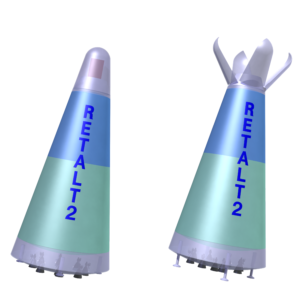
Five European Companies and the German Aerospace Center (DLR) have teamed up to tackle the shortcoming of know-how in reusable rockets in Europe, which start upright and land upright after a successful mission.
For that, they commonly decided to investigate and develop key technologies to land rockets backwards. What is state-of-the-art in the USA is only in its beginnings in Europe, and the consortium is determined to accept the challenge and to become important players in this game changing technology.
RETALT (RETro propulsion Assisted Landing Technologies) is a European project which got funded with €3 million by the European Commission in the frame of Horizon 2020. The partnering organizations are the DLR (Germany), CFS Engineering (Switzerland), Elecnor Deimos (Spain), MT Aerospace (Germany), Almatech (Switzerland) and Amorim Cork Composites (Portugal).
During the three years of the project lifetime the consortium will investigate the areas of aerodynamics, aerothermodynamics (i.e. the temperatures that evolve at the surface of the vehicle during flight), flight dynamics, guidance, navigation and control, and advanced structural parts, materials and mechanisms. For this purpose, two types of rocket launchers will be investigated which both start and land in an upright position. One of them will have two stages and will be similar to conventional rockets like the Falcon 9 or the Ariane 5 launcher. For this launcher only the first stage will be landed again. The second launcher has only a single stage. It will be designed for the use of smaller payloads and when returning it will break not only with retro propulsion but also with the aid of a large aerodynamic base surface at the bottom.
These rockets will not really be launched; however, they will be used as the reference configurations for the investigations of the different technologies in the project. Aerodynamic wind tunnel experiments, numerical simulations and ground tests of several components will serve to verify the outcomes of the project.
“In the USA, Retro-Propulsion is being practiced. However, the phenomena and physics behind the technologies are not completely understood. With high quality data from wind tunnel experiments and ground demonstrators combined with numerical simulations, we will be able to understand the details and take a big leap towards applicability of reusability in Europe,” Prof. Ali Gülhan states, Project Coordinator of the DLR. “The know-how for a rapid application of re-usability in European launchers can only come from a strong common effort of research and industry,” he adds.
The objective of the project is to raise the Technical Readiness Level (a measure of 1 to 9 of how far a technology is away from market readiness) up to 5 for most of the technologies investigated in the project and up to 3 for the Guidance and Navigation and Control system. This means that the technologies will be demonstrated in a representative environment and can be tested in prototypes in a next step. The partners strive for concepts of reusable launch vehicle that best combine all the investigated technologies in a single design, in view of a demonstration in orbit in followup projects.
The DLR is responsible for the coordination of the project, the design of the reference configurations and the assessment of aerodynamics and aerothermodynamic behavior via wind tunnel tests and Computational Fluid Dynamics (CFD) simulations. Likewise, CFS Engineering is performing CFD simulations and is, furthermore, responsible for the dissemination and exploitation of the results of the project. The responsibility of Elecnor Deimos is the Flight Dynamics and the development of a Guidance, Navigation and Control concept for the reference configurations. MT Aerospace is developing structural components like the landing legs and aerodynamic control surfaces and will manufacture scaled demonstrators of the structures. Almatech is designing mechanisms for the structural parts and is responsible for the conception of a Thrust Vector Control (TVC) system. Amorim Cork Composites is designing the Thermal Protection System (TPS) for critical structural parts especially the base area of the launchers which will be tested in hot plume wind tunnel tests at the DLR.





